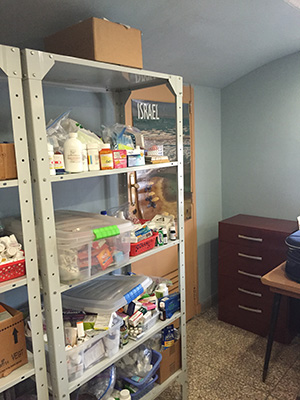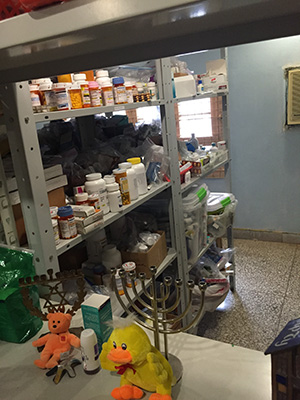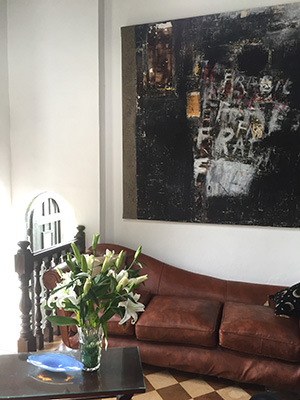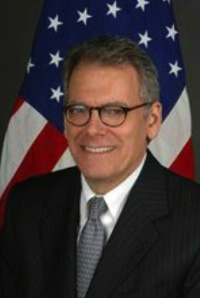Cuba Policy Trip – Day 3
The day started with a visit with Archdiocese spokesman Orlando Marquez. Marquez is the founder of the Catholic monthly magazine Palabra Nueva and the director of the press office of the Cuban Conference of Catholic Bishops.
On April 17, the Vatican said Pope Francis may add another leg to his trip to the United States this September, visiting Cuba just months after he helped negotiate a diplomatic thaw between the two nations. Pope Francis, the first pontiff to hail from Latin America, played a key role in the re-establishment of diplomatic relations between Cuba and the United States, earning praise from both President Barack Obama and Cuban President Raul Castro. The Pope made personal pleas to Obama and Cuban leaders in private letters, writing that the two nations should try to reset their relations after decades of friction. The Vatican also hosted talks between U.S. and Cuban delegations in October, where they hashed out aspects of a new trade policy and discussed the release of Alan Gross.
Two previous Popes have visited the Caribbean nation: St. John Paul II in 1998 and former Pope Benedict XVI in 2012. Fidel Castro attended the mass held – in private clothes – and a holiday was granted for all to attend.
The Catholic Church is the only NGO in Cuba. The Palabra Nueva is the only magazine in the country which is not censored. It is published monthly with a distribution of 10,000. The Church applied for a License to legally publish, but has never heard back from the government. The articles cover not only religion but also cultural, sports, science and other subjects. The National Library keeps copies, so they can be read by the public. Government officials just prefer not to “see” the magazine. The mission is to bridge different options, to be part of the solution, and to express options with respect.
After the revolution, all the foreign priests left, resulting in a shortage of priests. After 1959, most churches were expropriated and made into schools, cultural centers, etc. The Germany Catholic Church via the Adveniat Fund began supporting the Church in Cuba. There is some funding from the US Church also. According to Archdiocese spokesman Orlando Marquez, most of the Cuban population are believers and about 60 percent are baptized. After the revolution, atheism grew, as did Santeria, a more private religion.
Following the visit with Marquez, we paid a visit to the Patronato de la Casa de la Comunidad Hebrea / the Patronato Synagogue – where we saw the recently renovated sanctuary. Our speaker told us Cuba’s Jewish community used to be the most prosperous in Latin America until the 1959 Revolution, when the majority of the Cuban Jewish population fled. After the Cuban government announced in 1992 that Cubans could practice their religion, a slow revival began. First opened in 1953, the Patrodato is one of the two functioning synagogues in Havana, and its revival marks a new era for Havana. (Cuban Jewish Community)

Note – There were three Jews in the first ship of Christopher Columbus to Cuba.
On September 13, which is Fidel Castro’s birthday, Israel donates funds to Cuba. The Israelis are very active in Panama and also in Cuba. When Fidel Castro gave an interview to Atlantic Monthly by Jewish author Jeffrey Goldberg, Castro said he admired the Jewish people.
In 1906 Jews first arrived in Cuba for business. Many more arrived after WWI and WWII and synagogues were built in 1950s. There were 15,000 Jews before 1959 but 80 percent left to go to Miami. It became very difficult for the remaining. There was no funding – only retired people came to the Temple, which never closed.
Now there is a Sunday school with 80 attending, with a total of 170 attendees, as there are classes for adults now too. Technically private schools not allowed, but the government ignores this. There is also a free pharmacy, as often there is shortage in government pharmacies, especially of antibiotics. Also, many on the island have allegories / asthma due to the humidity. The pharmacy is open two days a week and non-Jews are welcome.


There is no permanent Rabbi, but visiting Rabbis have taught others to lead services. Over 100 people attend regularly and on holidays over 400 attend. There are now 1300 Jews in Cuba, with 800 in Havana.
Food for Passover is supplied to every family by Canadians and New Yorkers. Both Castro’s have visited synagogues and there is a good relation with the government.
Many of the Jews get married to non Jews, so there is a conversion course offered. They will also accept the marriage if their father is Jewish. There is good amount of travel to Israel. The Canadians handle much for the Jewish community. There are two cars which drive seniors to the weekly services. They have 5 Torahs – the last one donated from New Jersey. Passover is in Spanish. There is even a kosher ration from the government.
Support is slowly coming from Israel now and there is a good relationship with the Synagogue in Miami.
There is Jewish cemetery, but it is in bad condition. Quite literally, people don’t want to spend money on the dead – but would rather focus on food and medical needs.
Next, we had lunch at the beautiful Paladar Atelier, formerly the home of a pre-revolution senator. Restaurant owner Niryus Herrera joined us for lunch and told us about the history and vision of the restaurant. With a menu that changes every day, the restaurant prides itself in its originality, often called an “experimental culinary workshop.”
The owners borrowed money from all their family to start the restaurant. A major difficulty is obtaining supplies. They travel to other Caribbean nations to bring back kitchen equipment, but food items are also scarce. They would like to establish a private functioning retail market, and then much later develop a wholesale process. They have hopes of expanding their restaurant in the future.

Next on to Nostalgicars. We met with Owner Julio Alvarez to talk about the history of vehicles in Cuba. Most of the cars on the roads are American and Soviet import vehicles from the 1950s. From 1959-2014, the majority of Cubans could only legally purchase cars made before 1959, with the exception of those with special government permits. Although the ban was removed in 2014, cars were taxed at such a high rate that only the wealthiest can afford a new car. (Internations). The car owners with whom we spoke, however, maintained a positive attitude about the classic cars, which give Cuba a unique and historic atmosphere.
There are approximately 50,000 classic or nostalgic cars in Cuba. There are still many cars in people’s garages that have been sitting for years – mainly due to economic reasons i.e. cost of gas and maintenance. And, as the older generation passes on, the younger generation is more willing to sell the cars.
It can take 4 to 7 months to refurbish a car. Most cars are rebuilt with diesel engines. There are 10 employees and the company includes 12 taxis. Owner Alvarez’s assistant spoke fluent English, as he previously was an English professor. The company imports parts from all over the world including New York and Santa Ana, CA. I gave our hosts my business card, however, cards are new in Cuba- and they had just ordered cards the day prior for the first time.
The owner had met with New York Governor Cuomo the day prior, so there was a related article in the New York Times. The owner had also been interviewed by NPR.
We then switched gears and visited the home of Jose Fuster, a plastic artist, who has transformed his neighborhood (Fusterlandia) into a colorful array of art. Here is a link to a video of his work. Fuster has more than 100 exhibitions around the world and has been featured in hundreds of shows. Much of the money he makes, he puts right back into the community.
The artist had visited Barcelona and said Picasso was his “god father” and Gaudi was his “uncle”. He started during the “special period” (after the fall of the Soviet Union) and all he could do was to bring a little hope to his neighbors by creating art for the locals. Since then he has continued to make art and sell it to visitors. He takes no money from the government or any foundations.
We then drove though the residential area of Miramar where the one percent lived before 1959 i.e. Bacardi’s etc. Now the homes are mainly embassies or government owned.
See photo of Soviet Embassy:
The delegation once again switched gears to meet for drinks and a briefing at the residence of Ambassador Jeffrey DeLaurentis, a career member of the Senior Foreign Service, who is the Chief of Mission at the U.S. Interests Section in Havana, Cuba. Following normalization, he will become charge d’affaires, which confers much the same status as ambassador, and DeLaurentis could well be the president’s choice for the historic posting of a U.S. ambassador to the island nation after a 54-year hiatus.
Ambassador DeLaurentis has been posted in Havana on two other occasions during his state department career, as consular officer from 1991-1993 and as Political-Economic Section Chief from 1999-2002.
The embassy has both U.S. and local employees mainly focused on visas. And even though it isn’t an “embassy”, the U.S. nonetheless has the largest diplomatic presence in Cuba. (Although it is possible the Russian Embassy hired one more individual in order to make that claim).


(At the moment, there is no Cuban diplomatic representation in the US. However, there exists a Cuban Interests Section of the Embassy of Switzerland in Washington, D.C., headed by Ambassador Jose R. Cabanas Rodriguez).
Our delegation sat comfortably in the residence living room and had a lengthy briefing and conversation with Ambassador DeLaurentis. He said he would always remember where he was when the December 17 announcement came. (Our guide even said, with a twinkle in his eye, that the day is almost viewed as BC and AD).
The Ambassador described the three rounds of negotiations, which have taken place so far and the need for a fourth. A major sticking point in that the U.S. demands the new Embassy would operate under the Vienna Convention and have total access in Cuba.
An overall concern is one of managing expectations. Raul Castro is expected to step down in 2018, and it is assumed that First Vice President Miguel Diaz-Canel will follow. He is younger and was born following the revolution. He is expected to be more open regarding the internet, etc.
As we know, on December 17, 2014, Presidents Barack Obama and Raúl Castro announced during simultaneous broadcasts their intentions to start to normalize relations between the two countries.
Major elements of the Obama’s new approach include:
• Establishing diplomatic relations with Cuba;
• Adjusting regulations to more effectively empower the Cuban people;
• Facilitating an expansion of travel under general licenses for the 12 existing categories of travel to Cuba authorized by law;
• Facilitating remittances to Cuba by U.S. persons;
• Authorizing expanded commercial sales/exports from the United States of certain goods and services;
• Authorizing U.S. citizens to import additional goods from Cuba;
• Facilitating authorized transactions between the United States and Cuba;
• Initiating new efforts to increase Cubans’ access to communications and their ability to communicate freely;
• Updating the application of Cuban sanctions in third countries;
• Pursuing discussions with the Cuban and Mexican governments to discuss the unresolved maritime boundary in the Gulf of Mexico
Although we did not visit the office of the U.S. Interests Section of Cuba – here is a photo -the 6-story edifice was formerly the location for the US Embassy, which opened in 1953. The building was re-opened in 1977 with renovations complete in the late 1990s.
For dinner we went to the delicious Ivan Chef Justo, located across the street from the Museum of the Revolution on the second and third floors of a historic building. Here is a short video of the restaurant.
We sat upstairs on the small slightly slanted patio and enjoyed a meal that was well presented and tasted great! This restaurant prides itself in its ever-changing menu, which is characteristic of Cuban restaurants. (This may also really be due to the regular lack of availability of food items).
